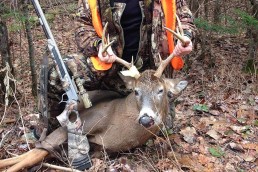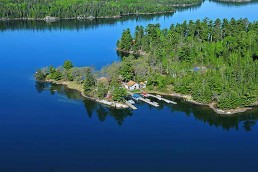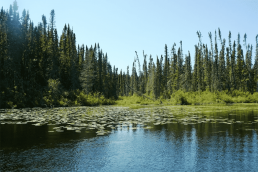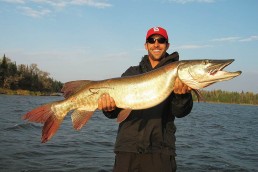A Big Bloodless Buck
by Chris Bailey
I first started deer hunting in 1992, and my deer education began in Ontario WMU 61(Wildlife Management Unit). The southwest corner starts at Madoc, with the west boundary going up Highway 62 to Bancroft, across Highway 28 to 41 and then down and back to Highway 7.
The southern end is the beginning of a transition from farmland into the Canadian Shield. But if you’re going to farm it, you better like rocks. For the most part, you are hunting mixed hardwoods with many small lakes and rivers.The areas I prefer to set up around are the many marsh areas plentiful throughout. Most of the hunting camps use dogs too, and your setup can be on runways. The dogger does a push, hoping to start a “chase and push” on a deer and force it to go past one of the shooters.
After my first two years deer hunting, my dad convinced me to try turkey hunting—this type changed my entire outlook. I thought that if you can converse with and call turkeys, why not deer? Most of my deer-calling knowledge has come from videos and trial and error. I shot my first buck during my third season with the aid of a Quaker Boy bleat-n-heat can and my father’s crossbow.
The first 13 years, I primarily hunted deer in WMU 61. But when the owner of the camp decided to divide the ownership into eight shares, my dad and I built our own cabin on our farm in WMU 68B. The last 12 years in the fall I’ve gun-hunted deer in WMU 68B. The members of the old camp I hunted out of in WMU 61 are all friends, so when two of the owners decided to start muzzleloader hunting there three years ago, I didn’t hesitate and asked to join them.
Muzzleloader season opens the first week of December, and we usually have six to eight guys move into the camp on that Sunday and then we head home on Wednesday morning. The first two seasons we had some close encounters, but never closed the deal. This year, I was focusing again on hunting from a treestand.
I met my buddy Jeff Duffin at camp on the Sunday and he drove me over to the stand in his side-by-side, a 30-minute travel. I proceeded to saturate the area with dominant buck urine and hang tampons soaked with estrus doe urine. I put two bags of corn 90 yards out and covered them with molasses; the corn was between two runways in the marsh.
The morning on the opener was crisp and clear as I climbed into the treestand at 7:40 a.m. I started my first calling sequence ten minutes later, with four estrus doe calls on my Woods Wise original breeding bellow. After that, I broadcast-called every 15 to 20 minutes, doing one to five estrus calls. Just after 8:30 I did some buck popping followed with a tending grunt on my Hunter Specialties True Talker.
Shortly after that, I then spotted a big deer on the far south shore. I texted two buddies from camp, Greg Woodbeck and Rob Donohoe, telling them I got a big buck on the other side of the lake. I figured if I could see it that plain at that distance, it had to be a big buck.
A few minutes later, I saw the big buck follow a doe.
I turned up the power on my Nikon scope and could see a nice set of antlers. He was about 150 yards behind her and they were traveling east around the lake. As they went out of sight, I texted my friends once again that the deer were coming my way. Even though it was 850 yards to the south shore, they would have to travel about twice as far around this lake to get to me, but I felt sure they were coming. Every five minutes or so I’d do either an estrus doe bleat or a single grunt, just to let them know where I was. I focused on a point to my left at 250 yards. Then, like magic, she was right at my focal point and still coming with her neck straight up looking my way.
When the deer got about 100 yards out it turned left on one of the runways and went straight to the corn. With the animal nice and relaxed, I then turned my focus back to the point. When he rounded the corner, my T/C Pro Hunter was pointed at him. What a magnificent sight—a big rutting buck grunting and following a doe, getting closer with every step.
I now had my range finder in my left hand, keeping track of the distance. He glanced a couple times at the doe, but was focused on where he heard that “other” buck grunting. His neck was stretched straight up and very swollen, but his glare was mostly my way. I figured when he got to 100 yards he would turn and follow her, presenting me with a perfect broadside, 90- yard shot.
But I had figured wrong; he broke off her trail and continued northeast.
With the wind out of the southwest, it looked as if he was now trying to circle to my left and catch my wind. I had to make a quick decision whether or not to shoot him when he passed a nearby tree, because after that he’d be off the marsh and into the woods and be able to wind me without presenting a shot.
Even though I didn’t like it, I had to take the quartering-to-me shot. So, when he passed the tree at 75 yards, I dropped the hammer on him. It looked and sounded like a good hit, right behind the front shoulder. Judging by his reaction, I thought I smashed him, but he was able to make a little circle and go 25 yards off the marsh and into the woods to the east. I couldn’t believe he made the woods because it looked like he was going down.
The texts were now coming in like crazy and I let them know that I think I’d made a good shot, but was going to give him 45 minutes because of the quartering-at angle. After the time was up, I got down and searched for the next 30 minutes, not finding a trace of blood.
Rob then texted me that he was on the way. I just went from the highest high to feeling doubt. When I heard Rob’s Rhino coming I made my way back up in my treestand because the view is obviously different from the ground. This way, I could show him where the buck was when I shot it and where he left the marsh. Rob and I looked around for another 30 minutes and never found any blood.
“This is ridiculous,” I said, turning to Rob. “I smashed him and he should be lying over that knob, dead.”
“I’m going to check over there,” Rob said.
The next thing Rob heard as he walked for a few moments away was a celebration call from me; I had spotted my buck.
The deer hadn’t gone 70 yards from where I shot him, and when we got to it there still wasn’t any blood. Rob, being a police officer, had to investigate. He found the entrance hole right behind the left shoulder, but we couldn’t find the exit wound.
By this time, the entire camp had arrived and they made me feel like a million bucks—what a great bunch of guys.
But Rob couldn’t let it go and kept searching on the carcass. Then, he noticed the buck’s right hind leg was broken. He found a lump on the leg and took out his knife and proceeded to cut out my T/C Shock Wave slug.
The camp was so happy for our first muzzleloader deer, a nice buck. We’d figured the time from my first sighting until his demise was about 40 minutes.
I’ve hunted for 12 years out of camp X. My memories from back there will last forever. Most of my deer-hunting knowledge I’ve acquired has come from the mistakes I’ve made in those early years there. Mind you, when you make a mistake, everyone has lots of good advice for you to learn from and apply—good-old hindsight.
Each year that I’ve come home from the hunt I’ve had to learn more about deer vocalizations. And as a result, I now have a huge audio and video library. I’ve shot lots of deer at camp X, and many of them have come to the call. I’ve called and shot bigger bucks at our camp in WMU 68B, but that buck I caught on opening weekend was my biggest so far out of WMU 61, and was definitely the most satisfying.
It’s such a great feeling when you completely fool a mature buck and get to watch him come from that far off.
MWO
SHARE THIS POST
You may also like...
Did you enjoy this post?
You can be among the first to get the latest info on where to go, what to use and how to use it!
MWO
We believe being outdoors is good. With more than 1,000 articles each year, MidWest Outdoors magazine is all about sharing outdoor experiences with you—where to go, what to use and how to use it… whether you’re close to home or on that trip of a lifetime.



